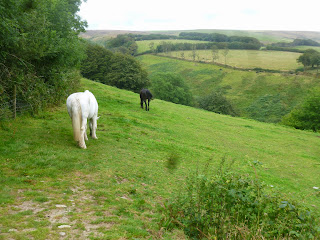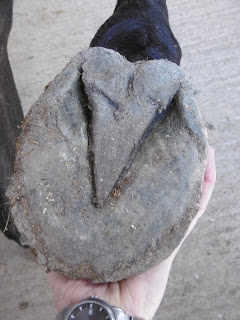"My horse needs shoes, he can't cope barefoot."
"I'm shoeing him - he's footy because of the hard ground - he needs extra protection."
There are lots of reasons why horses can become footy but there is really only one reason why, at this time of year, a horse which has been "coping" out of shoes suddenly "needs" shoes. That reason is plain, simple and all around us - yep, its grass.
We in the UK grow grass amazingly well - lots of sunshine (I'm generalising...), lots of rain and nice mild temperatures - perfect! Not only is grass at its richest in summer - with high levels of sugar and starch - but many horses are turned out for much longer than at other times of the year.
This combination of factors puts a huge number of horses at risk and a horse becoming footy should act as an early warning system.
In a barefoot horse you have a huge advantage - a horse who is footy out of shoes is letting you know that the grass is too sugary and starchy for his system to cope with - and you can do something about it while its still a minor, reversible problem.
You don't normally need to take a horse off grass completely (provided you haven't let it get to the stage of full blown laminitis!).
Steps for getting the horse back to soundness can be as simple as bringing a horse off grass during the day (while the flies are worst and when he may be very happy to be inside with a haynet) or using a grazing muzzle for part of the time.
Adding additional magnesium (which is often in short supply in sweet grass) can also be a very effective remedy as low magnesium levels contribute to sole sensitivity.
Or, if thats too difficult or doesn't fit with how you want to keep your horse you can of course stick a set of shoes on him.
The problem is that the grass is still sweet, still starchy and still too much for your horse's system. Its just that the effects aren't so obvious. When your horse loses a shoe he will still be footy, and as his foot gets used to being in shoes his feet are likely to become weaker - particularly the palmar foot - the frog, heels and digital cushion - which work hard barefoot but have a lot less to do in a shoe.
But that's ok, isn't it? Well, maybe. The real issue is that now you have a foot which is unhealthy because the horse is getting too much sugar and starch and weak because its in a shoe...So now you really have a horse which "needs" a shoe because his feet are so compromised he is crippled out of them.
If we are logical we can see that horses cope well with hard surfaces out of shoes - they don't "need" shoes - its the opposite - in fact their feet need, and thrive on, work on tough surfaces; that is what makes the healthiest feet. Its a nonsense to say that horses "can't cope" with tough surfaces barefoot. The truth is that they can't cope with tough surfaces when their feet are weak and unhealthy.
A good diet is the essential foundation for healthy hooves, as you've heard me say many times before, and the horse has evolved to eat much less rich grass, on the whole, than the stuff we grow in our fields today. So we are back to the grass again.
To me its a basic truth - feed a horse an appropriate diet and work his feet correctly out of shoes and he will have healthy feet. Feed him a high sugar, high starch diet and watch his soundness reduce. At that stage you can shoe him but you will be on a downward spiral and the longer you shoe the longer you will "need" them- and that's the shoeing irony.



































































